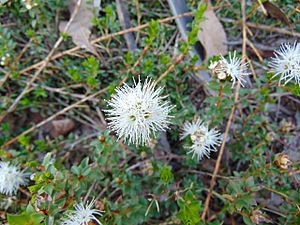Muntries facts for kids
Quick facts for kids Muntries |
|
|---|---|
 |
|
| Kunzea pomifera in the ANBG | |
| Scientific classification | |
| Genus: |
Kunzea
|
| Species: |
pomifera
|
Muntries (also called emu apples or native cranberries) are a special type of plant. Their scientific name is Kunzea pomifera.
These plants are low-growing shrubs, meaning they don't get very tall. They often spread out along the ground. Muntries have small, egg-shaped leaves and pretty white flowers. They also grow tasty, round, edible fruits.
Contents
What Muntries Look Like
Muntries are shrubs that grow close to the ground. Their young stems are a bit hairy. Sometimes, their main branches even grow roots into the soil.
Leaves, Flowers, and Fruit
The leaves of the muntrie plant are arranged one after another along the stem. They are usually egg-shaped or almost round. Each leaf is about 3 to 8 millimeters long and 3 to 6 millimeters wide.
Muntrie flowers are white or cream-colored. They grow in small groups of three to eight flowers at the ends of the branches. These flowers have tiny, brown, triangular parts called sepals. The white petals are small, about 1 to 2 millimeters long.
After the flowers bloom, the plant grows its fruit. The fruit is round and fleshy, like a berry. It's about 8 to 12 millimeters wide. When the fruit is ripe, it turns a deep red, purple, or even black color.
How Muntries Got Their Name
The scientific name for muntries, Kunzea pomifera, was first given in 1855. A scientist named Ferdinand von Mueller described the plant. He found it growing on sandy shores and rocks in places like Gulf St Vincent in Australia.
Meaning of the Name
The second part of the name, pomifera, comes from two Latin words. Pomum means "fruit" or "apple." Fero means "to carry" or "to bear." So, pomifera means "fruit-bearing" or "apple-bearing," which makes sense because the plant grows edible fruits!
Where Muntries Grow
Muntries naturally grow in parts of Victoria and South Australia.
Natural Habitat
In Victoria, you can mostly find muntries in sandy soil. They grow in areas like the Little Desert and Big Desert. There are also smaller groups of them near Portland and Nelson.
In South Australia, muntries also prefer sandy soil, often where there is limestone. They grow between the Yorke Peninsula and the border with Victoria.
Uses of Muntrie Berries
The berries from muntrie plants are about 1 centimeter across. They are green with a little red when they are ready to eat. They taste like a spicy apple!
Healthy Benefits
Muntrie berries have a crunchy texture. They are very healthy because they contain a lot of antioxidants. In fact, they can have up to four times more antioxidants than blueberries! Antioxidants are good for your body. The berries also have natural waxes that are good for keeping your skin healthy.
Growing Muntries
Muntries were first grown in England in 1889. They were one of the first Australian plants to be grown in other countries.
Training Plants on Trellises
In the wild, muntries usually spread out on the ground. But farmers who grow them for sale often use a method called trellising. This means they train the plants to grow up and along wires, like a fence.
Trellising makes it easier to pick the berries and manage the plants. It also helps farmers use their land more efficiently. You can train muntrie plants by gently weaving them through the wires and using ties to hold them in place.
Soil and Water Needs
Muntries like soil that drains well. They can grow in soil that is slightly acidic to quite alkaline.
In their natural environment, muntries usually get about 500 to 800 millimeters of rain each year. When growing them, it's important to avoid both too much water (waterlogging) and very dry soil. Giving them a little less water in early spring might help them produce more flowers and fruit. Some people say that giving muntries too much water can make the berries lose some of their spicy apple flavor.
See also
 In Spanish: Muntries para niños
In Spanish: Muntries para niños


